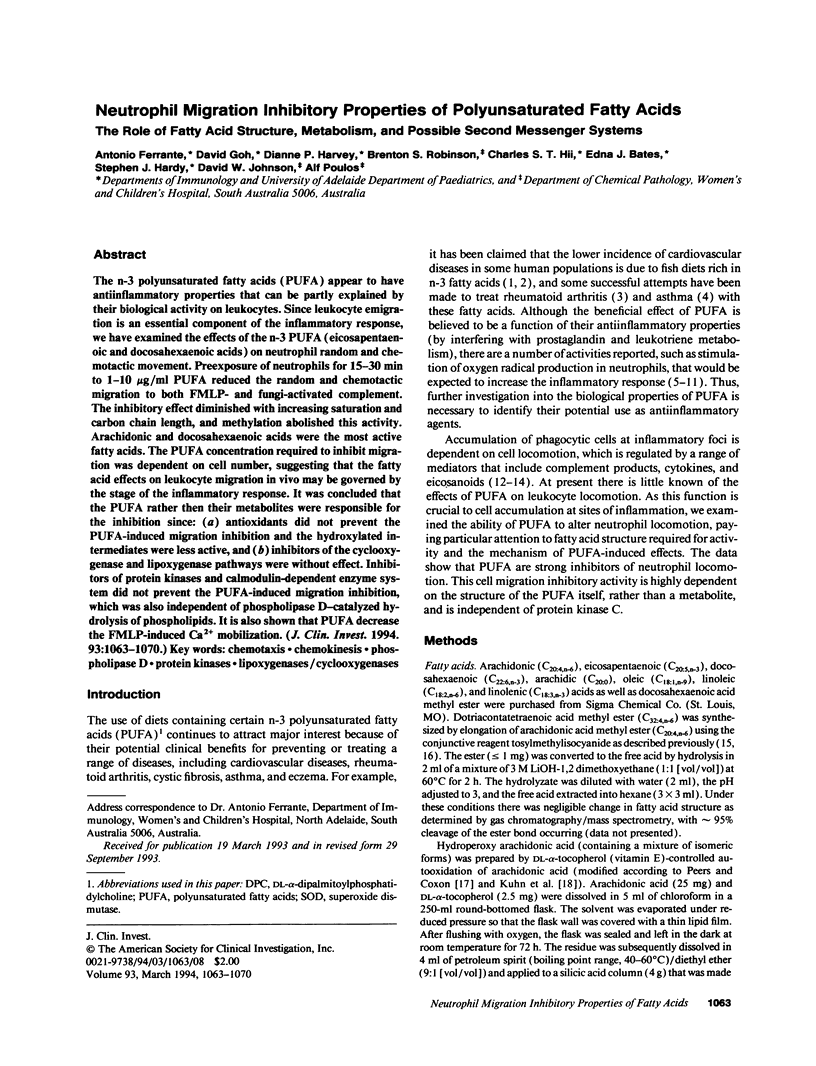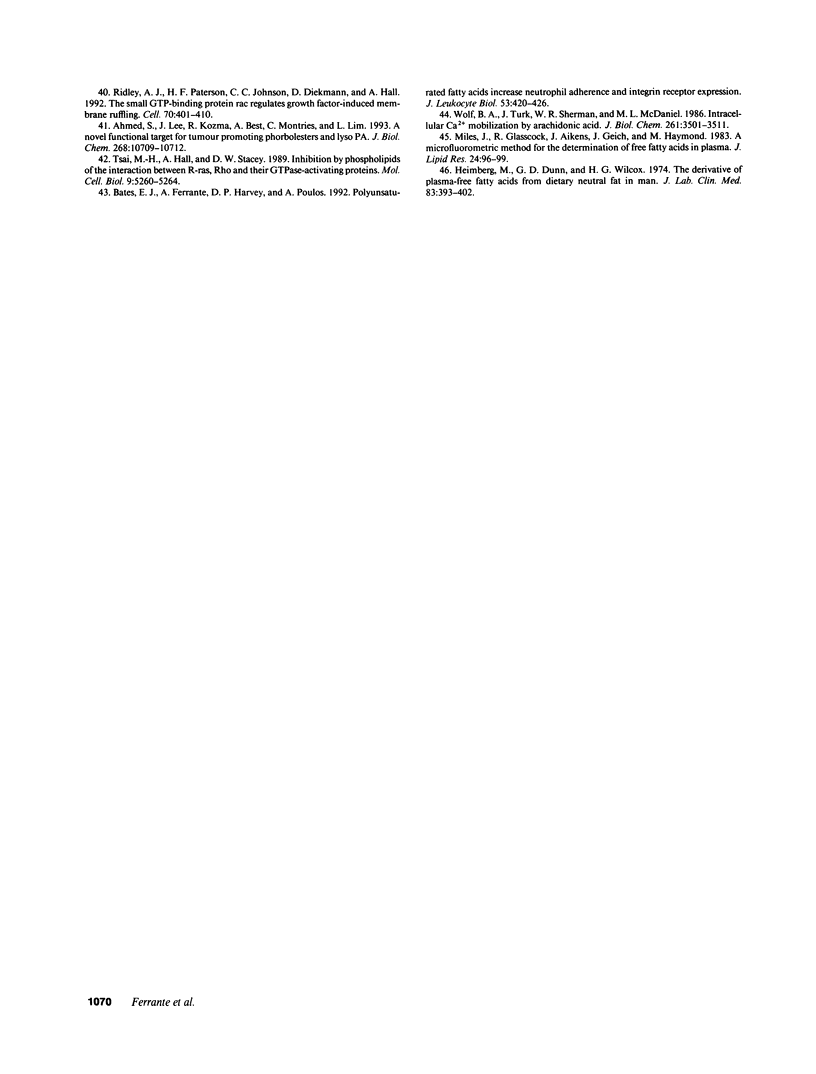Abstract
The n-3 polyunsaturated fatty acids (PUFA) appear to have antiinflammatory properties that can be partly explained by their biological activity on leukocytes. Since leukocyte emigration is an essential component of the inflammatory response, we have examined the effects of the n-3 PUFA (eicosapentaenoic and docosahexaenoic acids) on neutrophil random and chemotactic movement. Preexposure of neutrophils for 15-30 min to 1-10 micrograms/ml PUFA reduced the random and chemotactic migration to both FMLP- and fungi-activated complement. The inhibitory effect diminished with increasing saturation and carbon chain length, and methylation abolished this activity. Arachidonic and docosahexaenoic acids were the most active fatty acids. The PUFA concentration required to inhibit migration was dependent on cell number, suggesting that the fatty acid effects on leukocyte migration in vivo may be governed by the stage of the inflammatory response. It was concluded that the PUFA rather than their metabolites were responsible for the inhibition since: (a) antioxidants did not prevent the PUFA-induced migration inhibition and the hydroxylated intermediates were less active, and (b) inhibitors of the cyclooxygenase and lipoxygenase pathways were without effect. Inhibitors of protein kinases and calmodulin-dependent enzyme system did not prevent the PUFA-induced migration inhibition, which was also independent of phospholipase D-catalyzed hydrolysis of phospholipids. It is also shown that PUFA decrease the FMLP-induced Ca2+ mobilization.
Full text
PDF







Images in this article
Selected References
These references are in PubMed. This may not be the complete list of references from this article.
- Abramson S. B., Leszczynska-Piziak J., Weissmann G. Arachidonic acid as a second messenger. Interactions with a GTP-binding protein of human neutrophils. J Immunol. 1991 Jul 1;147(1):231–236. [PubMed] [Google Scholar]
- Badwey J. A., Curnutte J. T., Karnovsky M. L. cis-Polyunsaturated fatty acids induce high levels of superoxide production by human neutrophils. J Biol Chem. 1981 Dec 25;256(24):12640–12643. [PubMed] [Google Scholar]
- Badwey J. A., Curnutte J. T., Robinson J. M., Berde C. B., Karnovsky M. J., Karnovsky M. L. Effects of free fatty acids on release of superoxide and on change of shape by human neutrophils. Reversibility by albumin. J Biol Chem. 1984 Jun 25;259(12):7870–7877. [PubMed] [Google Scholar]
- Bonser R. W., Thompson N. T., Randall R. W., Garland L. G. Phospholipase D activation is functionally linked to superoxide generation in the human neutrophil. Biochem J. 1989 Dec 1;264(2):617–620. doi: 10.1042/bj2640617. [DOI] [PMC free article] [PubMed] [Google Scholar]
- Cleland L. G., French J. K., Betts W. H., Murphy G. A., Elliott M. J. Clinical and biochemical effects of dietary fish oil supplements in rheumatoid arthritis. J Rheumatol. 1988 Oct;15(10):1471–1475. [PubMed] [Google Scholar]
- Corey S. J., Rosoff P. M. Unsaturated fatty acids and lipoxygenase products regulate phagocytic NADPH oxidase activity by a nondetergent mechanism. J Lab Clin Med. 1991 Oct;118(4):343–351. [PubMed] [Google Scholar]
- Curnutte J. T. Activation of human neutrophil nicotinamide adenine dinucleotide phosphate, reduced (triphosphopyridine nucleotide, reduced) oxidase by arachidonic acid in a cell-free system. J Clin Invest. 1985 May;75(5):1740–1743. doi: 10.1172/JCI111885. [DOI] [PMC free article] [PubMed] [Google Scholar]
- Dawson R. M. The formation of phosphatidylglycerol and other phospholipids by the transferase activity of phospholipase D. Biochem J. 1967 Jan;102(1):205–210. doi: 10.1042/bj1020205. [DOI] [PMC free article] [PubMed] [Google Scholar]
- Devreotes P. N., Zigmond S. H. Chemotaxis in eukaryotic cells: a focus on leukocytes and Dictyostelium. Annu Rev Cell Biol. 1988;4:649–686. doi: 10.1146/annurev.cb.04.110188.003245. [DOI] [PubMed] [Google Scholar]
- Dry J., Vincent D. Effect of a fish oil diet on asthma: results of a 1-year double-blind study. Int Arch Allergy Appl Immunol. 1991;95(2-3):156–157. doi: 10.1159/000235421. [DOI] [PubMed] [Google Scholar]
- Ferrante A., Beard L. J., Thong Y. H. Early decay of human neutrophil chemotactic responsiveness following isolation from peripheral blood. Clin Exp Immunol. 1980 Feb;39(2):532–537. [PMC free article] [PubMed] [Google Scholar]
- Ferrante A., Thong Y. H. Separation of mononuclear and polymorphonuclear leucocytes from human blood by the one-step Hypaque-Ficoll method is dependent on blood column height. J Immunol Methods. 1982;48(1):81–85. doi: 10.1016/0022-1759(82)90212-5. [DOI] [PubMed] [Google Scholar]
- Ferrante A. Tumor necrosis factor alpha potentiates neutrophil antimicrobial activity: increased fungicidal activity against Torulopsis glabrata and Candida albicans and associated increases in oxygen radical production and lysosomal enzyme release. Infect Immun. 1989 Jul;57(7):2115–2122. doi: 10.1128/iai.57.7.2115-2122.1989. [DOI] [PMC free article] [PubMed] [Google Scholar]
- Grynkiewicz G., Poenie M., Tsien R. Y. A new generation of Ca2+ indicators with greatly improved fluorescence properties. J Biol Chem. 1985 Mar 25;260(6):3440–3450. [PubMed] [Google Scholar]
- Hardy S. J., Robinson B. S., Poulos A., Harvey D. P., Ferrante A., Murray A. W. The neutrophil respiratory burst. Responses to fatty acids, N-formylmethionylleucylphenylalanine and phorbol ester suggest divergent signalling mechanisms. Eur J Biochem. 1991 Jun 15;198(3):801–806. doi: 10.1111/j.1432-1033.1991.tb16084.x. [DOI] [PubMed] [Google Scholar]
- Heimberg M., Dunn G. D., Wilcox G. The derivation of plasma-free fatty acids from dietary neutral fat in man. J Lab Clin Med. 1974 Mar;83(3):393–402. [PubMed] [Google Scholar]
- Hidaka H., Sasaki Y., Tanaka T., Endo T., Ohno S., Fujii Y., Nagata T. N-(6-aminohexyl)-5-chloro-1-naphthalenesulfonamide, a calmodulin antagonist, inhibits cell proliferation. Proc Natl Acad Sci U S A. 1981 Jul;78(7):4354–4357. doi: 10.1073/pnas.78.7.4354. [DOI] [PMC free article] [PubMed] [Google Scholar]
- Hoover R. L., Fujiwara K., Klausner R. D., Bhalla D. K., Tucker R., Karnovsky M. J. Effects of free fatty acids on the organization of cytoskeletal elements in lymphocytes. Mol Cell Biol. 1981 Oct;1(10):939–948. doi: 10.1128/mcb.1.10.939. [DOI] [PMC free article] [PubMed] [Google Scholar]
- Koul O., Hauser G. Modulation of rat brain cytosolic phosphatidate phosphohydrolase: effect of cationic amphiphilic drugs and divalent cations. Arch Biochem Biophys. 1987 Mar;253(2):453–461. doi: 10.1016/0003-9861(87)90199-8. [DOI] [PubMed] [Google Scholar]
- Kromhout D., Bosschieter E. B., de Lezenne Coulander C. The inverse relation between fish consumption and 20-year mortality from coronary heart disease. N Engl J Med. 1985 May 9;312(19):1205–1209. doi: 10.1056/NEJM198505093121901. [DOI] [PubMed] [Google Scholar]
- Kuhn H., Belkner J., Wiesner R., Brash A. R. Oxygenation of biological membranes by the pure reticulocyte lipoxygenase. J Biol Chem. 1990 Oct 25;265(30):18351–18361. [PubMed] [Google Scholar]
- Kumaratilake L. M., Robinson B. S., Ferrante A., Poulos A. Antimalarial properties of n-3 and n-6 polyunsaturated fatty acids: in vitro effects on Plasmodium falciparum and in vivo effects on P. berghei. J Clin Invest. 1992 Mar;89(3):961–967. doi: 10.1172/JCI115678. [DOI] [PMC free article] [PubMed] [Google Scholar]
- Lands W. E. Biochemistry and physiology of n-3 fatty acids. FASEB J. 1992 May;6(8):2530–2536. doi: 10.1096/fasebj.6.8.1592205. [DOI] [PubMed] [Google Scholar]
- Lee T. H., Hoover R. L., Williams J. D., Sperling R. I., Ravalese J., 3rd, Spur B. W., Robinson D. R., Corey E. J., Lewis R. A., Austen K. F. Effect of dietary enrichment with eicosapentaenoic and docosahexaenoic acids on in vitro neutrophil and monocyte leukotriene generation and neutrophil function. N Engl J Med. 1985 May 9;312(19):1217–1224. doi: 10.1056/NEJM198505093121903. [DOI] [PubMed] [Google Scholar]
- Miles J., Glasscock R., Aikens J., Gerich J., Haymond M. A microfluorometric method for the determination of free fatty acids in plasma. J Lipid Res. 1983 Jan;24(1):96–99. [PubMed] [Google Scholar]
- Nelson R. D., Quie P. G., Simmons R. L. Chemotaxis under agarose: a new and simple method for measuring chemotaxis and spontaneous migration of human polymorphonuclear leukocytes and monocytes. J Immunol. 1975 Dec;115(6):1650–1656. [PubMed] [Google Scholar]
- Poulos A., Johnson D. W., Beckman K., White I. G., Easton C. Occurrence of unusual molecular species of sphingomyelin containing 28-34-carbon polyenoic fatty acids in ram spermatozoa. Biochem J. 1987 Dec 15;248(3):961–964. doi: 10.1042/bj2480961. [DOI] [PMC free article] [PubMed] [Google Scholar]
- Poulos A., Robinson B. S., Ferrante A., Harvey D. P., Hardy S. J., Murray A. W. Effect of 22-32 carbon n-3 polyunsaturated fatty acids on superoxide production in human neutrophils: synergism of docosahexaenoic acid with f-met-leu-phe and phorbol ester. Immunology. 1991 May;73(1):102–108. [PMC free article] [PubMed] [Google Scholar]
- Ridley A. J., Hall A. The small GTP-binding protein rho regulates the assembly of focal adhesions and actin stress fibers in response to growth factors. Cell. 1992 Aug 7;70(3):389–399. doi: 10.1016/0092-8674(92)90163-7. [DOI] [PubMed] [Google Scholar]
- Ridley A. J., Paterson H. F., Johnston C. L., Diekmann D., Hall A. The small GTP-binding protein rac regulates growth factor-induced membrane ruffling. Cell. 1992 Aug 7;70(3):401–410. doi: 10.1016/0092-8674(92)90164-8. [DOI] [PubMed] [Google Scholar]
- Rossi F., Grzeskowiak M., Della Bianca V., Calzetti F., Gandini G. Phosphatidic acid and not diacylglycerol generated by phospholipase D is functionally linked to the activation of the NADPH oxidase by FMLP in human neutrophils. Biochem Biophys Res Commun. 1990 Apr 16;168(1):320–327. doi: 10.1016/0006-291x(90)91711-z. [DOI] [PubMed] [Google Scholar]
- Salmon E. D. Cytokinesis in animal cells. Curr Opin Cell Biol. 1989 Jun;1(3):541–547. doi: 10.1016/0955-0674(89)90018-5. [DOI] [PubMed] [Google Scholar]
- Steinbeck M. J., Robinson J. M., Karnovsky M. J. Activation of the neutrophil NADPH-oxidase by free fatty acids requires the ionized carboxyl group and partitioning into membrane lipid. J Leukoc Biol. 1991 Apr;49(4):360–368. doi: 10.1002/jlb.49.4.360. [DOI] [PubMed] [Google Scholar]
- Tanaka T., Kanegasaki S., Makino R., Iizuka T., Ishimura Y. Saturated and trans-unsaturated fatty acids elicit high levels of superoxide generation in intact and cell-free preparations of neutrophils. Biochem Biophys Res Commun. 1987 Apr 29;144(2):606–612. doi: 10.1016/s0006-291x(87)80009-8. [DOI] [PubMed] [Google Scholar]
- Tsai M. H., Hall A., Stacey D. W. Inhibition by phospholipids of the interaction between R-ras, rho, and their GTPase-activating proteins. Mol Cell Biol. 1989 Nov;9(11):5260–5264. doi: 10.1128/mcb.9.11.5260. [DOI] [PMC free article] [PubMed] [Google Scholar]
- Yamaguchi T., Kaneda M., Kakinuma K. Effect of saturated and unsaturated fatty acids on the oxidative metabolism of human neutrophils. The role of calcium ion in the extracellular medium. Biochim Biophys Acta. 1986 Oct 23;861(3):440–446. doi: 10.1016/0005-2736(86)90452-9. [DOI] [PubMed] [Google Scholar]



